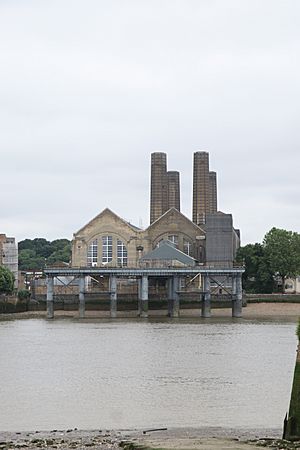Greenwich Power Station facts for kids
Quick facts for kids Greenwich Power Station |
|
|---|---|

Greenwich Power Station with The O2 visible in the background.
|
|
| Country | United Kingdom |
| Location | Greater London |
| Coordinates | 51°29′06″N 0°00′04″W / 51.485°N 0.001°W |
| Status | Operational |
| Construction began | 1902 |
| Commission date | 1906 |
| grid reference TQ389781 | |
Greenwich Power Station is a big building next to the River Thames in Greenwich, south-east London. It's a power station that can make electricity using gas. In the past, it also used oil and coal.
This power station was first built to power London's trams. Since 1988, it has been the main emergency power source for London Underground. This means it provides electricity if the main power grid (called the National Grid) has problems. This helps keep the Tube running safely.
How Greenwich Power Station Started
The power station was built on land that used to be a tram depot. A special law, called the London County Council (Tramways and Improvement) Act 1902, allowed the London County Council to build new tram lines and this power station.
The famous architect William Edward Riley designed the station. It was built in two main parts between 1902 and 1910. Its main job was to provide electricity for the London County Council's tram system. The first part of the station officially opened on May 26, 1906. Any extra power it made was also used by other electric tram lines.
The station originally had a boiler house that burned coal. The coal was brought in by barges on the River Thames. It also had an engine room with large steam engines that created electricity.

The building itself was one of the first in London to use a steel frame. It was covered with brick and stone. It is about 114 meters long and 59 meters wide, and its roof is about 24 meters high. The building has two main sections. The west side, which used to be the boiler house, is now where the turbines are. The east side, once the engine room, is mostly unused today.
By 1910, engineers realized that steam turbines were much better than the old steam engines. So, four steam turbines were put in during the second stage of building. The original steam engines were replaced by these new turbines in 1922.
Changes Over Time
The first two chimneys at the power station were very tall, about 249 feet high. But the nearby Royal Observatory complained. The power station was right below the Prime Meridian, which is a very important line for mapping the world. The tall chimneys might have blocked their view. So, the chimneys built in the second stage were made shorter, only 180 feet high. Later, between 1969 and 1972, the taller chimneys were also made shorter to match the others.
The steam turbines were eventually replaced by Rolls-Royce gas turbine generators. These generators first used oil as fuel, but they were later changed to use both oil and gas. They are still located in what used to be the boiler house. These generators can produce 117.6 megawatts of power. This power is sent to the London Underground's electricity system.
The gas turbines were first added to help out London Underground's other power station at Lots Road. In 1998, London Underground started using power from the National Grid. Lots Road Power Station was then shut down. This made Greenwich Power Station London's only original power station still working. Its six engines now provide emergency power. This means if the main power grid goes down, Greenwich Power Station can still help people safely leave the underground network.
In 2015, there was a plan to add up to six new gas engines at Greenwich Power Station. The idea was to provide steady, cleaner power for the Tube. It would also provide hot water and heating for nearby schools and homes. However, people living nearby worried about more air pollution. So, the plan was stopped in December 2016.
How It Works Today
In the past, coal was brought to the power station by barges. These barges would unload at a large coal jetty (a pier) in the river. This jetty stands on 16 strong, cast iron columns. From 1927, the coal was moved to large storage bunkers.
When the station switched to using oil, the cranes that moved coal were removed. The jetty was changed so that fuel oil could be pumped from river tankers onto the land. However, the pier is not used anymore. Any oil needed at the station now comes by road tanker.
In 2020, the turbines at Greenwich Power Station were turned on about once a month for up to two hours. This was to make sure they were ready in case of an emergency. In January 2021, one of the gas turbine generators caught fire and was damaged.

